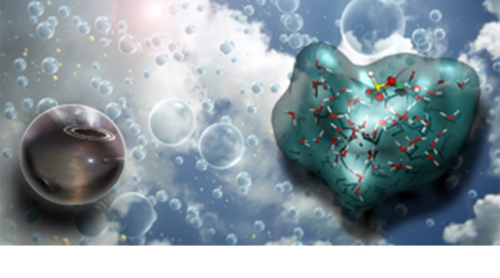A team of researchers at the Fritz Haber Institute of the Max Planck Society in Berlin, the Qatar Environment and Energy Research Institute/Hamad Bin Khalifa University, the synchrotrons PETRA III (Hamburg) and SOLEIL, the Sorbonne University (Paris), the ETH Zurich, and the PSI Center for Energy and Environmental Science (Switzerland) have made a groundbreaking discovery in understanding how air pollution forms at the molecular level.
Their investigation, published in Nature Communications, sheds light on the complex chemical processes occurring at the boundary between liquid, in particular aqueous solutions, and vapor in our atmosphere.
At SOLEIL, PLEIADES beamline contributed to these results.
(Source: Fritz Haber Institute)
The international study focuses on the differences of complex acid-base equilibria (i.e., the ratio between basic and acidic components) inside the bulk of a solution on one hand, and at the very interface between the solution and the surrounding vapor on the other. While it is straightforward to measure acid-base equilibria in the bulk of a solution using state-of-the art methods, determining these equilibria at the boundary between a solution and the surrounding gas phase is challenging. Even though this boundary layer is about one hundred thousand times narrower than a human hair, it plays a very important role in processes that influence air pollution and climate change. Examining the chemistry of the solution-vapor boundary on a molecular scale thus helps to develop improved models for our understanding of the fate of aerosols in the atmosphere and their influence on the global climate.
SOLEIL’s contribution
The liquid jet electron spectroscopy experiment at PLEIADES beamline contributed to a series of measurements carried out principally at the PETRA III synchrotron (P04 beamline, Germany), as well as at the Swiss Light Source (Surface/Interface Microscopy beamline, Switzerland) aimed at establishing the complex chemical processes occurring at the boundary between liquid, particularly aqueous solutions, and vapor in our atmosphere.

Figure 1: the PLEIADES beamline’s experimental station where measurements were made.
Key Findings
1. Complex acid-base equilibria determined: The researchers used complementary spectroscopic methods to unravel the complex acid-base equilibria that result when the pollutant sulfur dioxide (SO2) is dissolved in water.
2. Unique behavior at the liquid-vapor interface: Under acidic conditions, the tautomeric equilibrium between bisulfite and sulfonate is strongly shifted towards the sulfonate species.
3. Stabilization at the interface: Molecular dynamic simulations revealed that the sulfonate ion and its acid (sulfonic acid) are stabilized at the interface due to ion pairing and higher dehydration barriers, respectively. This explains why the tautomeric equilibria are shifted at the interface.
Implications for Air Pollution
The findings highlight the contrasting behaviors of chemicals at the interface versus the bulk environment. This difference significantly impacts how sulfur dioxide is absorbed and reacts with other pollutants like nitrogen oxides (NOx) and hydrogen peroxide (H2O2) in the atmosphere. Understanding these processes is crucial for developing strategies to reduce air pollution and its harmful effects on health and the environment.

Graphic abstract: Combined spectroscopy and atomistic simulations provide an improved understanding of specific molecular level processes governing air pollution formation. The cloudy background of the image is taken from NASA's Goddard Space Flight Center, repository image s3v-1280 (https://svs.gsfc.nasa.gov/11685/).
